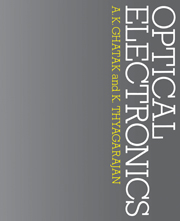Book contents
- Frontmatter
- Contents
- Preface
- 1 Maxwell's equations and propagation of electromagnetic waves
- 2 Reflection and refraction of electromagnetic waves
- 3 Wave propagation in anisotropic media
- 4 Fraunhofer diffraction
- 5 Fresnel diffraction
- 6 Spatial frequency filtering
- 7 Holography
- 8 Lasers: I
- 9 Lasers: II
- 10 Some laser systems
- 11 Electromagnetic analysis of the simplest optical waveguide
- 12 Leaky modes in optical waveguides
- 13 Optical fibre waveguides
- 14 Integrated optics
- 15 The electrooptic effect
- 16 The strain optic tensor
- 17 Acoustooptlc effect: Raman–Nath diffraction
- 18 Acoustooptic effect: Bragg diffraction
- 19 Acoustooptic devices
- 20 Nonlinear optics
- Appendices
- References and suggested reading
- Index
2 - Reflection and refraction of electromagnetic waves
Published online by Cambridge University Press: 05 June 2012
- Frontmatter
- Contents
- Preface
- 1 Maxwell's equations and propagation of electromagnetic waves
- 2 Reflection and refraction of electromagnetic waves
- 3 Wave propagation in anisotropic media
- 4 Fraunhofer diffraction
- 5 Fresnel diffraction
- 6 Spatial frequency filtering
- 7 Holography
- 8 Lasers: I
- 9 Lasers: II
- 10 Some laser systems
- 11 Electromagnetic analysis of the simplest optical waveguide
- 12 Leaky modes in optical waveguides
- 13 Optical fibre waveguides
- 14 Integrated optics
- 15 The electrooptic effect
- 16 The strain optic tensor
- 17 Acoustooptlc effect: Raman–Nath diffraction
- 18 Acoustooptic effect: Bragg diffraction
- 19 Acoustooptic devices
- 20 Nonlinear optics
- Appendices
- References and suggested reading
- Index
Summary
Introduction
In this chapter we will study the reflection and refraction of electromagnetic waves from an interface separating two media and from a stack of films. Such studies are very important in understanding many practical optical devices such as Fabry–Perot etalons, interference filters, special optical coatings etc. Furthermore, by studying the state of polarization of a light beam reflected from, a medium, one can obtain its optical characteristics; this forms the basis of the field of ellipsometry.
In deriving the reflection and transmission coefficients we will use the following continuity conditions at the interface:
(a) continuity of the tangential components of the electric vector E;
(b) continuity of the normal components of the displacement vector D;
(c) continuity of the tangential components of the magnetic field vector H and
(d) continuity of the normal components of the magnetic induction vector B.
We will find that the equations determining the reflection and transmission coefficients fall into two groups: one of the groups contains only the components of E parallel to the plane of incidence (and H perpendicular to the plane) and the other group contains only the components of E perpendicular to the plane of incidence (and H parallel to the plane). Therefore the two cases (being independent of each other) will be considered separately and using them we can study the reflection (and refraction) of electromagnetic waves which have arbitrary states of polarization.
- Type
- Chapter
- Information
- Optical Electronics , pp. 27 - 62Publisher: Cambridge University PressPrint publication year: 1989



